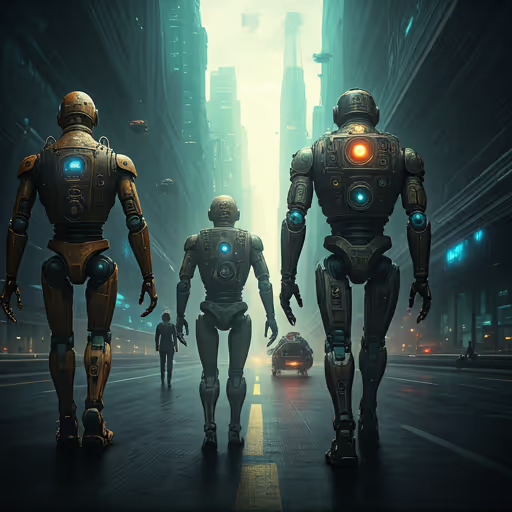The Rise of AI in Urban Environments
As cities become more interconnected and data-driven, artificial intelligence (AI) is playing an increasingly central role in transforming urban landscapes into “smart cities.” The image of three humanoid robots walking through a neon-lit, futuristic cityscape symbolizes the seamless integration of AI-powered robotics into everyday urban life. From traffic management to public safety, AI is enhancing efficiency, sustainability, and connectivity, redefining how cities operate.
Humanoid Robots: The Faces of Intelligent Mobility
Humanoid robots in smart cities are not just symbols of technological advancement; they are active participants in improving urban mobility. Equipped with advanced sensors, machine learning algorithms, and real-time data analysis, these robots can navigate complex cityscapes, assist in transportation, and provide critical support in emergencies. Their human-like form allows them to interact naturally with city residents, fostering trust and collaboration between technology and people.
AI-Powered Infrastructure: A New Urban Ecosystem
Smart cities thrive on interconnected systems where data flows seamlessly between devices, infrastructure, and people. AI-powered robots are essential components of this ecosystem, acting as both data collectors and active decision-makers. They monitor traffic, optimize energy consumption, and provide personalized services in real-time. For instance, AI robots can assist pedestrians in navigating congested areas, direct autonomous vehicles, or even deliver goods efficiently.
The Challenges of AI-Driven Urbanization
While the vision of AI robots in smart cities is inspiring, it is not without challenges. Questions around data privacy, ethical AI deployment, and equitable access to these technologies must be addressed. Ensuring that these systems are inclusive and designed to benefit all city residents is critical to building trust and long-term sustainability.
Synergy Between Humans and Machines
The humanoid robots depicted in this image also highlight the potential for AI to foster collaboration between humans and machines in urban spaces. These robots are not meant to replace human activity but to enhance it. By taking over repetitive, dangerous, or time-sensitive tasks, they allow humans to focus on creativity, innovation, and community building.
Conclusion
The futuristic cityscape with humanoid robots is a glimpse into a new era where AI seamlessly integrates into urban life. These intelligent systems are transforming cities into hubs of innovation, connectivity, and sustainability. However, the success of this transformation depends on ensuring that AI-powered solutions are developed responsibly, with an emphasis on inclusivity and ethical considerations. The future of smart cities is not just about technology—it’s about creating spaces where humans and machines can thrive together, walking side by side into a brighter future.
